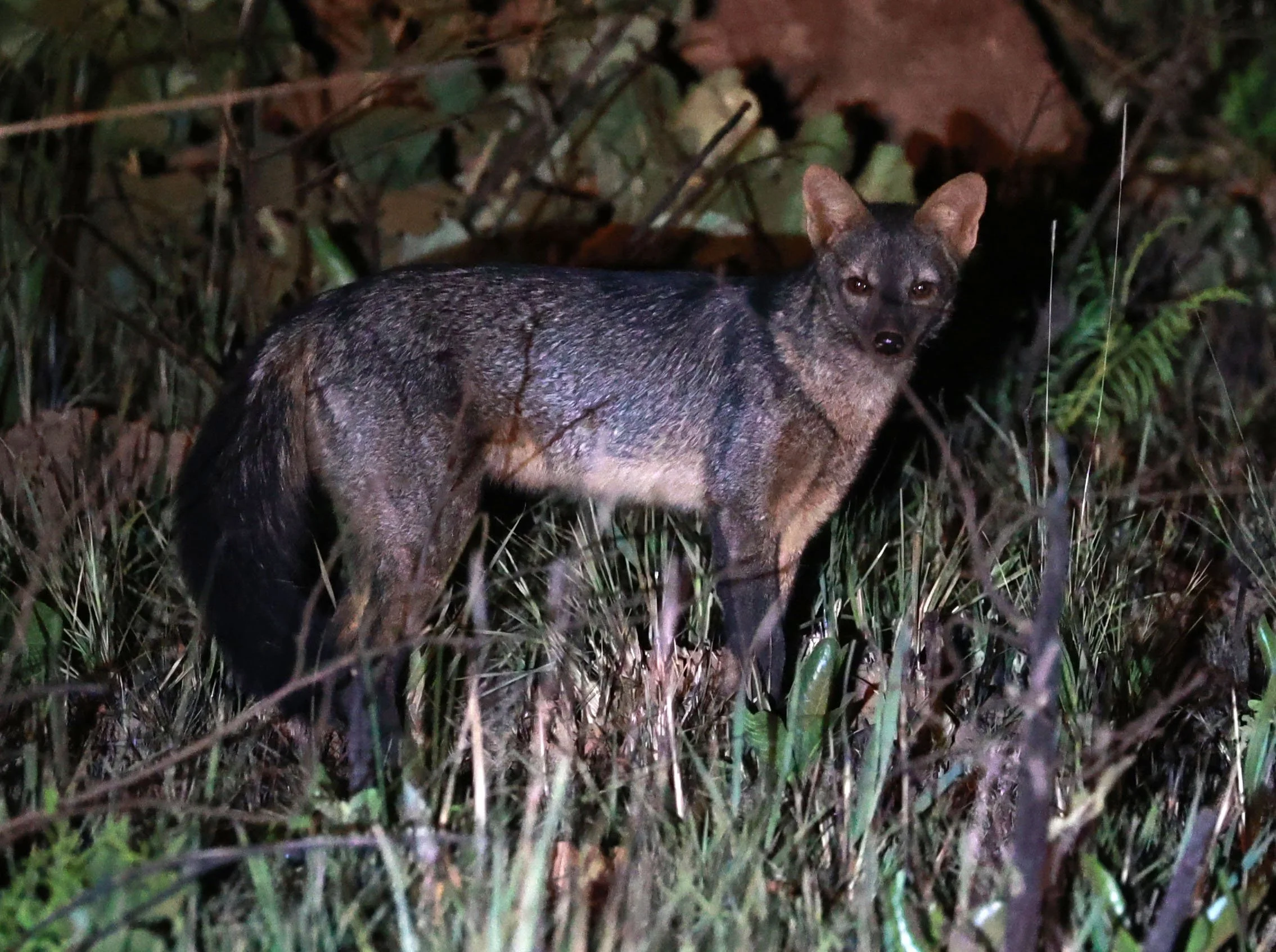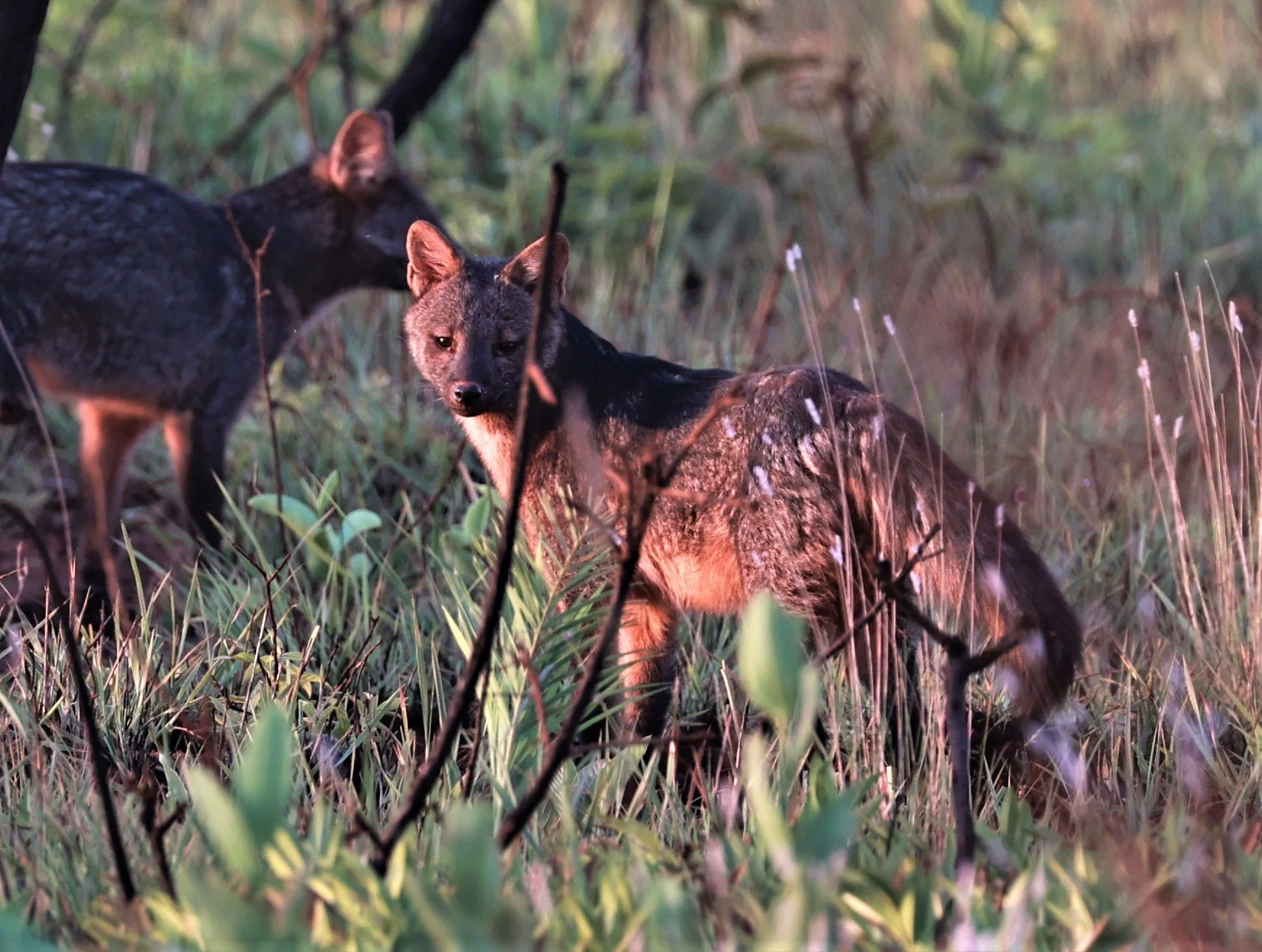
Crab-eating Fox (Cerdocyon thous)
The Crab-eating Fox (Cerdocyon thous), also known as the forest fox, wood fox, bushdog (not to be confused with the bush dog) or maikong, is an extant species of medium-sized canid endemic to the central part of South America since at least the Pleistocene epoch. Like South American foxes, which are in the genus Lycalopex, it is not closely related to true foxes. Cerdocyon comes from the Greek words kerdo (meaning fox) and kyon (dog) referring to the dog- and fox-like characteristics of this animal.
The crab-eating fox is predominantly greyish-brown, with areas of red on the face and legs, and black-tipped ears and tail. It has short, strong legs and its tail is long and bushy. The head and body length averages 64.3 centimetres (25.3 in), and the average tail length is 28.5 centimetres (11.2 in). It can weigh between 10 and 17 pounds (4.5 and 7.7 kg).
The coat is short and thick. Coloration varies from grey to brown, to yellowish, to pale, to dark grey. There is a black streak along the back legs, with a black stripe along the spine. On muzzle, ears and paws there is more-reddish fur. The tail, legs and ear tips are black. The ears are wide and round. The torso is somewhat narrow; legs are short but strong. The dense hairy tail stays upright when they are excited. There is significant variation in color between population, from very dark to light grey-yellow.
Genetically, there are 74 diploid chromosomes (36 pairs).
Crab-eating Fox in Emas National Park, Goias, Brazil
The crab-eating fox is a canid that ranges in savannas; woodlands; subtropical forests; prickly, shrubby thickets; and tropical savannas such as the caatinga, plains, and campo, from Colombia and southern Venezuela in the north to Paraguay, Uruguay and northern Argentina at the southernmost reaches of its range. The crab-eating fox has also been sighted in Panama since the 1990s.
Its habitat also includes wooded riverbanks such as riparian forest. In the rainy season, their range moves uphill, whilst in drier times they move to lower ground. Their habitat covers all environments except rainforests, high mountains, and open grassy savannas. In some regions of their range, they are threatened with extirpation.
The crab-eating fox creates monogamic teams for hunting; groups of several monogamic pairs may form during the reproductive season. Population density estimates vary between one individual per 4 km2 in Venezuela to 0.0003 individuals/km2 in Argentinian wetlands. Territorialism was noticed during the dry season; during rainy seasons, when there is more food, they pay less attention to territory. Hideouts and dens often are found in bushes and in thick grass, and there are typically multiple entrance holes per den. Despite being capable of tunneling, they prefer to take over other animals' burrows. Several characteristic sounds are made by the crab-eating fox such as barking, whirring and howling, which occur often when pairs lose contact with one another.
The crab eating fox is nocturnal, with peaks of activity in the middle of the night and the early morning.
The crab-eating fox searches for crabs on muddy floodplains during the wet season, giving this animal its common name. It is an opportunist and an omnivore, preferring insects or meat from rodents and birds when available. Other foods readily consumed include turtle eggs, tortoises, fruit, eggs, crustaceans, insects, lizards and carrion. Their diet is varied and has been found to differ by different researchers, suggesting opportunistic feeding and geographical variation. During the wet season, the diet contains more crabs and other crustaceans, while during the dry season it contains more insects. The crab-eating fox contributes to the control of rodents and harmful insects.
The Convention on International Trade in Endangered Species of Wild Fauna and Flora (CITES) lists the fox as not threatened by extinction. The IUCN lists the crab-eating fox as being of "Least Concern". There are no precise estimates of the population size, but it is common within its range and the population is stable.
It is considered a threat to livestock by farmers, which leads to illegal hunting in some countries. The primary threat to the fox is disease from unvaccinated dogs.
The below individuals were photographed at Pousada Aguape, Pantanal do Sul
The below individuals were photographed at Emas National Park, Goias, Brazil











































































































































